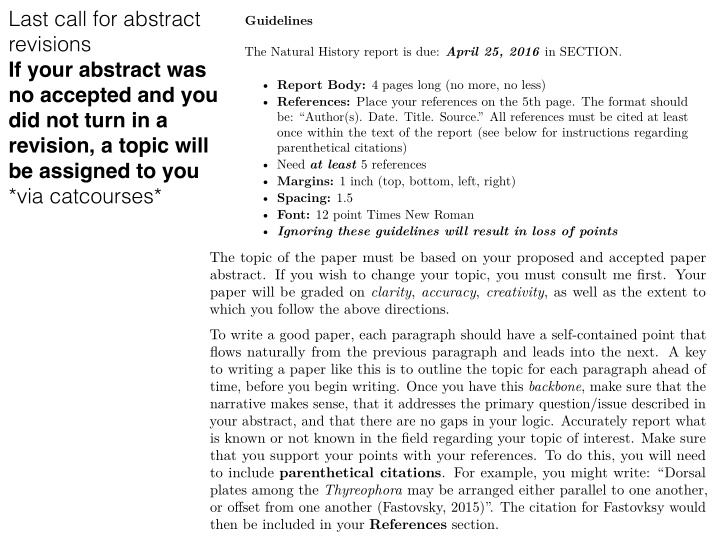



Last call for abstract Guidelines revisions The Natural History report is due: April 25, 2016 in SECTION. If your abstract was • Report Body: 4 pages long (no more, no less) no accepted and you • References: Place your references on the 5th page. The format should did not turn in a be: “Author(s). Date. Title. Source.” All references must be cited at least once within the text of the report (see below for instructions regarding revision, a topic will parenthetical citations) • Need at least 5 references be assigned to you • Margins: 1 inch (top, bottom, left, right) *via catcourses* • Spacing: 1.5 • Font: 12 point Times New Roman • Ignoring these guidelines will result in loss of points The topic of the paper must be based on your proposed and accepted paper abstract. If you wish to change your topic, you must consult me first. Your paper will be graded on clarity , accuracy , creativity , as well as the extent to which you follow the above directions. To write a good paper, each paragraph should have a self-contained point that flows naturally from the previous paragraph and leads into the next. A key to writing a paper like this is to outline the topic for each paragraph ahead of time, before you begin writing. Once you have this backbone , make sure that the narrative makes sense, that it addresses the primary question/issue described in your abstract, and that there are no gaps in your logic. Accurately report what is known or not known in the field regarding your topic of interest. Make sure that you support your points with your references. To do this, you will need to include parenthetical citations . For example, you might write: “Dorsal plates among the Thyreophora may be arranged either parallel to one another, or o ff set from one another (Fastovsky, 2015)”. The citation for Fastovksy would then be included in your References section.
Fastovsky ch. 12 + maybe ch. 11? (only if we cover these chapters in class)
Theropoda: Roadrunners from HELL.
Enter Saurischia! Saurischians: Two major clades: -Sauropodomorpha The Big -Theropoda The Bad The Ugly
What characterizes Saurischian Dinosaurs? 1. Subnarial foramen 2. Extra articulation on dorsal vertebrae 3. Twisted thumb Tyrannosaurus Ancestral characteristics: -’Lizard Hip’ three-pronged pelvis structure
Basal, non-sauropoda Saurischians Small Bipedal Fast-moving (how can you tell?) Carnivorous Herrerasaurus Eoraptor Possibly a very early sauropodomorpha: Saturnalia
Who were the Theropod dinosaurs? Second half of Saurischia, most closely related to Sauropods Represent some of the earliest known dinosaurs Eoraptor Herrerasaurus
Beast Foot Bird Foot
Hollow bones Tail stiff distally, used for balance Clawed hand with 3 elongated functional fingers and potentially opposable thumb (digit I) Shared, Derived Characteristics: 1) Clawed bipeds 2) Sharp, serrated teeth 3) Hollow vertebrae and limb bones 4) Reduction of outer fingers of hand 5) Stiff tail 6) 3 functional digits in foot
Theropod sizes
‘Bee Hummingbird’ is actually the smallest Theropod.
All Theropods are obligate bipeds Feet close to the midline Structural design was focused on: Ceratosaurus tracking (early form) attacking feeding Allosaurus (mid form) Deinonychus (later -derived- form)
~ Ceratosaurs ~ Spinosaurs Basal Theropods
Distribution of Basal Theropods
~ Therizinosaurs ~ Carnosaurs ~ Tyrannosaurs Intermediate Theropods
~ Troodontids ~ Dromaeosaurids Derived Theropods
Distribution of Intermediate and Derived Theropods
Oviraptor Therazinosaurs Avialae Tyrannosaurs Ceratosaurs Spinosaurs Troodontids Dromaeosaurids Carnosaurs Ornithomimosaurs Derived Intermediate Basal Theropods: Simplified
Ceratosaurs Ceratosaurus Coelophysis Robust hip joint Fusion of upper ankle bones for support Late Jurassic to Early Cretaceous Enormous bonebeds known for Coelophysis Dilophosaurus
Ceratosaurs Dracoraptor ~ earliest Jurassic Fed on small vertebrates Survived the Triassic Extinction Looks very ‘raptor-like’, but a distant ancestor
Spinosaurs Megalosaurus Strong shoulder, long arms Long, narrow snout Probably fish eaters Includes Megalosaurids Known for giant sails (but not across all taxa) Spinosaurus
Skulls are long, thin, and narrow Not good for attacking large, herbivores or any animal that would put up a fight (JP3 not- withstanding) Quick, powerful strikes on small prey Semi-aquatic lifestyles
Suchomimas
Baryonyx
Oviraptor Therazinosaurs Avialae Tyrannosaurs Spinosaurs Troodontids Dromaeosaurids Ceratosaurs Carnosaurs Ornithomimosaurs Derived Intermediate Basal Theropods: Simplified
Carnosaurs Big nostrils and elaborate sinuses Large bodied (> 5 m long) Big head Allosaurus
Carnosaurs Giganotosaurus; Late Cretaceous South America Skull was 6.3 ft long 16 meters (52 ft) long May have preyed on large Sauropods
Possibly a pack hunter. 16% larger brain than similar-sized carnivores *WINNING* Giganotosaurus; Late Cretaceous South America 16 meters (52 ft) long
Carnosaurs Charcarodontosaurus; Mid Cretaceous Africa 15 meters (50 ft) long
Carcharodont-osaurus ‘jagged tooth’-reptile
Recommend
More recommend